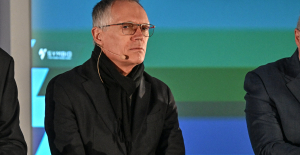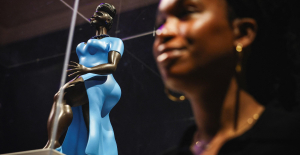Hardly any other hat symbolizes a country more clearly than the beret. A man with this headgear, striped shirt, Monbijou beard and baguette under his arm would be recognized as French even in the most remote corner of the world. The flat woolen hat is at least as good a Spaniard, because the Basque country has a French part as well as a Spanish part, which is even larger in terms of area.
From the old French province of Béarn in the Pyrenees, on the border with the Basque Country, the flat wool cap spread in the 15th century. The peasants wore it against the cold in winter and against the heat in summer. According to legend, the name of the hat with the little tail, as the Basques call the tip, comes from an error made by Napoleon III, who in 1855 admired the "béret basque" of the workers during a visit to the construction site of his summer palace in Biarritz.
Fulling mills, simple wooden mills that used pressure to press wool into felt, have existed in Europe since the High Middle Ages. This is how the raw material for the hats was produced back then. The Laulhère company, founded in 1830 and the last major beret producer in France, is based in the small town of Oloron-Sainte-Marie. There are also small manufacturers, such as Après La Pluie in the seaside resort of Saint-Jean-de-Luz, which make the hat next to Laulhère.
The military is a major buyer, but there are also school uniforms with the cap. The beret (French: béret) has another playground: the fashion industry. In 2017, for example, there was a black leather model by Dior. Gucci currently has a beret made of shiny logo fabric in its range for 310 euros and Acne one made of a snakeskin print. A simple, classic wool beret without fanfare costs less, around 50 euros.
Let's move on to another aspect of the hat: its straps. Even before the hype about the cap in intellectual and artistic circles in the 19th and 20th In the 19th century, she was found in self-portraits by the Dutch masters Vermeer and Rembrandt. The beret was worn by Rodin, Picasso, Monet, Cézanne, Hemingway and Richard Wagner. In the 1920s it became a symbol for the modern woman, worn by stars such as Marlene Dietrich, Greta Garbo and Coco Chanel.
During the Second World War, the beret was the headgear of the French resistance. She became a symbol of revolution. There are few pictures of Che Guevara without a beret. In 1967, Faye Dunaway wore it in "Bonnie and Clyde", around the same time the cap became a symbol of political resistance in the US for the Black Panther movement.
The "béret basque" has achieved what only a few items of clothing in the world can: Be a "sign of revolution", part of a uniform, a fashion statement and a national symbol at the same time. In France they would say: Oh, là, là!

 Knife attack in Australia: who are the two French heroes congratulated by Macron?
Knife attack in Australia: who are the two French heroes congratulated by Macron? Faced with an anxious Chinese student, Olaf Scholz assures that not everyone smokes cannabis in Germany
Faced with an anxious Chinese student, Olaf Scholz assures that not everyone smokes cannabis in Germany In the Solomon Islands, legislative elections crucial for security in the Pacific
In the Solomon Islands, legislative elections crucial for security in the Pacific Sudan ravaged by a year of war
Sudan ravaged by a year of war Covid-19: everything you need to know about the new vaccination campaign which is starting
Covid-19: everything you need to know about the new vaccination campaign which is starting The best laptops of the moment boast artificial intelligence
The best laptops of the moment boast artificial intelligence Amazon invests 700 million in robotizing its warehouses in Europe
Amazon invests 700 million in robotizing its warehouses in Europe Inflation rises to 3.2% in March due to gasoline and electricity bills
Inflation rises to 3.2% in March due to gasoline and electricity bills Olympic Games-2024: which professions are likely to strike during the competition?
Olympic Games-2024: which professions are likely to strike during the competition? Pizzas sold throughout France recalled for “possible presence” of glass debris
Pizzas sold throughout France recalled for “possible presence” of glass debris “As for a football player, there is a contract”: Carlos Tavares defends his remuneration of 36.5 million euros
“As for a football player, there is a contract”: Carlos Tavares defends his remuneration of 36.5 million euros Stellantis: shareholders validate the controversial remuneration of Carlos Tavares
Stellantis: shareholders validate the controversial remuneration of Carlos Tavares Dune 3 will be the last film of Denis Villeneuve's adaptation
Dune 3 will be the last film of Denis Villeneuve's adaptation Shane Atkinson, humble disciple of the Coen brothers
Shane Atkinson, humble disciple of the Coen brothers Outcry from publishers against the authorization of advertising for books on television
Outcry from publishers against the authorization of advertising for books on television Eddy de Pretto celebrates his “last party too many” at the Olympia
Eddy de Pretto celebrates his “last party too many” at the Olympia Skoda Kodiaq 2024: a 'beast' plug-in hybrid SUV
Skoda Kodiaq 2024: a 'beast' plug-in hybrid SUV Tesla launches a new Model Y with 600 km of autonomy at a "more accessible price"
Tesla launches a new Model Y with 600 km of autonomy at a "more accessible price" The 10 best-selling cars in March 2024 in Spain: sales fall due to Easter
The 10 best-selling cars in March 2024 in Spain: sales fall due to Easter A private jet company buys more than 100 flying cars
A private jet company buys more than 100 flying cars This is how housing prices have changed in Spain in the last decade
This is how housing prices have changed in Spain in the last decade The home mortgage firm drops 10% in January and interest soars to 3.46%
The home mortgage firm drops 10% in January and interest soars to 3.46% The jewel of the Rocío de Nagüeles urbanization: a dream villa in Marbella
The jewel of the Rocío de Nagüeles urbanization: a dream villa in Marbella Rental prices grow by 7.3% in February: where does it go up and where does it go down?
Rental prices grow by 7.3% in February: where does it go up and where does it go down? Europeans: the schedule of debates to follow between now and June 9
Europeans: the schedule of debates to follow between now and June 9 Europeans: “In France, there is a left and there is a right,” assures Bellamy
Europeans: “In France, there is a left and there is a right,” assures Bellamy During the night of the economy, the right points out the budgetary flaws of the macronie
During the night of the economy, the right points out the budgetary flaws of the macronie Europeans: Glucksmann denounces “Emmanuel Macron’s failure” in the face of Bardella’s success
Europeans: Glucksmann denounces “Emmanuel Macron’s failure” in the face of Bardella’s success These French cities that will boycott the World Cup in Qatar
These French cities that will boycott the World Cup in Qatar Dortmund-Atlético: two months before the Euro, Griezmann warms up the engine
Dortmund-Atlético: two months before the Euro, Griezmann warms up the engine Football: Bernd Hölzenbein, 1974 world champion, died at 78
Football: Bernd Hölzenbein, 1974 world champion, died at 78 'Everything comes to an end': Surfing legend Kelly Slater moves closer to retirement
'Everything comes to an end': Surfing legend Kelly Slater moves closer to retirement Athletics: the victory of a transgender athlete causes controversy in the United States
Athletics: the victory of a transgender athlete causes controversy in the United States


















